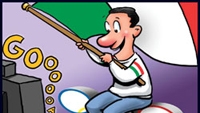Football fever fires HD roll-out

There is often talk of the Olympics being the premier sporting event in the broadcast calendar, but the recent experience of the World Cup confirms that the sport that creates the greatest interest around the globe is football — not synchronized swimming and dressage.
With a strong following across Europe, Asia, Latin America and Africa, hundreds of millions followed their national teams in a frenzy of flag waving. Major sporting events are always a driver for consumers to renew their television sets, as well as for cafes and bars to install bigger and better flat screens to pull in the crowds. 2006 just happened to coincide with the right business climate for many countries to start HD transmissions. Equipment is all multiformat, rather than the first round of products that often operated in only one standard, and the prices have fallen. Just as important, the prices of consumer products have fallen, so the demand for HD is coming from both sides.
In the lead up to the Cup and reading the many press releases that arrived in my in-box, it seemed that every vendor had an amazing new installation that gave broadcaster “X” the ability to provide enhanced coverage of the tournament.
In Europe, at the beginning of 2006, HD was very much in its infancy. To cover so many venues in HD, Europe’s OB fl eet saw a surge in truck building. In a competitive business with small returns, trucks are expected to have a working life of up to 15 years. A step change in technology like HD has rendered the existing fl eets obsolete. Surround sound adds to the problem, as the sound area now needs to be slightly larger than the usual closet provided for stereo monitoring.
Football has also seen broadcasters investing in the latest graphics technology. Sport has always demanded the most from graphics systems; it’s that combination of live scores and data-driven stats. With such large audiences, it has been easier to justify the investments for new systems with an event like the World Cup, more so than with any other programming.
HD was not the only technology that debuted with football coverage; the Italians were able to watch their team winning the World Cup on their mobile phones. Service providers and content creators are all watching the mobile space to see if other more run-of-the-mill programs will provide the need that makes mobile TV a compelling business proposition.
So, a win for Italy, but also a win for the equipment manufacturers, the service providers and, of course, all those soccer fans around the world.
The professional video industry's #1 source for news, trends and product and tech information. Sign up below.
Readers will notice the new design and presentation of Broadcast Engineering magazine. The staff has worked hard to bring you fresh, colorful, easy-to-read — yet always in-depth— coverage of this industry. Let us know what you think at editor@broadcastengineeringworld.com
DAVID AUSTERBERRY, EDITOR
Send comments to: editor@broadcastengineeringworld.com
